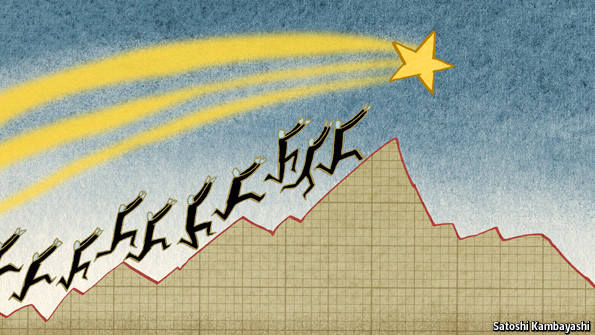Buttonwood
Double agents
The way investors choose fund managers may cause anomalies in the markets

The most striking anomaly is momentum—the fact that an asset that has recently been rising in price typically continues to do so. If markets were completely efficient, then past price movements should tell you nothing about the future. But lots of commodity-trading advisers, a type of hedge fund, make their living using sophisticated formulae to exploit this mysterious but abiding tendency.
A new paperfrom fund managers at one such group, Capital Fund Management, says the approach has been remarkably and persistently successful. Using data for stockmarkets and commodities, the authors were able to go all the way back to 1693 (for British shares) and 1784 (for sugar).
Their back-tested strategy was to buy those assets whose price was higher than its average over the previous five months, and to go short (bet on a further fall in price) on those assets that were below their average. They would then switch positions if prices fell below (or rose above) their five-month averages.
The result was a return that was profitable over all long periods (1800-1850, 1850-1900, 1900-1950 and 1950-today) and over each decade in the sample. The return from the long-short strategy was also higher than the return achieved by simply buying and holding the assets concerned. Trend-following has not been so profitable in recent years but the authors say that fallow periods have occurred in the past; there is no evidence (yet) to suggest the strategy has lost its potency.
The second anomaly relates to an old rule of thumb: greater risk demands greater reward. Academics have dressed up this principle as the “capital asset pricing model”: assets that are more volatile than average (or have a higher beta, in the jargon) should offer higher returns. In other words, risky technology stocks should be a more profitable investment, on average, than boring power utilities, since those that invest in the former are more likely to lose their shirts. In practice, however, less volatile (low beta) stocks have offered far higher returns than the theory would suggest. The capital asset pricing model is wrong.
Dimitri Vayanos and Paul Woolley of the London School of Economics have in the past explained the momentum effect through the principal-agent divide that occurs when investors employ fund managers. In a new paper with Andrea Buffa of Boston University, they employ similar reasoning to explain the low beta anomaly.
Investors judge fund managers by how successful they are relative to their peers, and to benchmarks such as the S&P 500 index. They reward “star” managers who have been successful in the past, giving them new funds to manage and taking money away from poor performers. This new money will be invested in the stocks the managers concerned favour, which are highly likely to be those that have recently performed well (that is why the managers are stars). Such shares will therefore continue to rise in price, which helps explain the momentum effect.
But fund managers also need to worry about underperforming the benchmark, since that will cause them to lose clients. The greatest risk is to have an underweight position in a big company that is rapidly rising in price (5% of the portfolio in a stock that is 10% of the index, for example). If such a stock rises (perhaps because of good news such as higher-than-expected profits), the distance from the benchmark grows. So underperforming fund managers will be under pressure to increase their holdings in such stocks, even if they consider them overvalued (this happened during the dotcom boom).
The result of all this, say the academics, will be to make such stocks both more expensive and more volatile. Less volatile stocks will become underpriced as a consequence. Eventually, however, the bubble will burst, and the more volatile stocks will fall in price, helping to explain why they produce disappointing returns over the long term.
0 comments:
Publicar un comentario